Vanderbilt LifeFlight has a rich history since it was developed in 1984. Check out these sections that highlight parts of our history, our patches and our logos.
-
- November 1983: The Tennessee Health Facilities Commission approves Vanderbilt University Medical Center's application to start Middle Tennessee's first air medical transport service.
- June 1984: VUMC dedicates its new LifeFlight program. The first aircraft in service is a
 Bell 206 LongRanger helicopter, owned and operated by Kenn Air for Vanderbilt.
Bell 206 LongRanger helicopter, owned and operated by Kenn Air for Vanderbilt.
- July 5, 1984: LifeFlight initiates operations.
- July 6, 1984: First patient transport occurs. Original flight crew members are Pilot Bill Hamblin and Flight Nurses Allison Bolin and Kathy Ogle.
- Early 1985: LifeFlight's initial helipad is removed in preparation for construction of the new Vanderbilt Clinic building. LifeFlight purchases a ground ambulance to facilitate patient transport from a temporary landing area on one of the University's athletic fields.
- Late 1985: Fourth floor rooftop helipad is completed with room for two helicopters. LifeFlight now has a dedicated elevator for direct access to the new helipad, operating suites, and emergency department.
- May 1986: Vanderbilt LifeFlight changes aviation vendors and upgrades to the twin engine BK-117, which is capable of simultaneous transport of two patients.
- July 1989: Vanderbilt LifeFlight celebrates its fifth anniversary.
- Summer 1990: LifeFlight presents "LifeFlight On Tour," a traveling series of lectures and aircraft site visits to hospital and EMS agencies in the Middle Tennessee region. This program later becomes what is now known as EMS Night Out.
- Fall 1990: The city of Nashville, along with Vanderbilt LifeFlight, hosts the international conference for the Association of Air Medical Services.
- Spring 1991: In cooperation with Middle Tennessee EMS agencies, LifeFlight initiates the Pre-Designated Emergency Landing Area program. The P.E.L.A. program was designed to assist local EMS services in identifying safe and efficient landing areas for LifeFlight to use on an on-going basis.
- October 1991: Vanderbilt LifeFlight receives the MBB Aeromedical Safety Award from the aircraft manufacturer for exceeding 5,000 consecutive accident-free missions.
- November 1991: LifeFlight's aviation vendor changes to Rocky Mountain Helicopters, and Vanderbilt receives a new BK-117 helicopter (N911VU) with the medical compartment's interior custom designed by Vanderbilt flight nurses.
- April 1992: First month of 100 patient transports.
- November 1992: LifeFlight begins carrying blood products on all flights. Two units of packed red blood cells are carried on every patient flight.
- Spring 1993: LifeFlight begins professional publication of a quarterly newsletter.
- Summer 1993: Three consecutive months of more than 100 patient transports each month.
- July 1994: Vanderbilt LifeFlight celebrates its ten-year anniversary.
- April 1997: LifeFlight expands operations by adding a second BK-117 along with additional staff including six flight nurses, five pilots, four flight coordinators, and one mechanic.
- June 1998: To meet the demand of increasing flight requests, LifeFlight 2's hours of operation are expanded from 12 hours a day to 16 hours a day.
- August 1998: Using advanced pilot training along with an electronic flight instrumentation system, a digital auto-pilot, and global positioning system, LifeFlight 1 (N117BK) initiates single pilot IFR capability, enhancing safety and increasing LifeFlight's availability during inclement weather.
- September 1998: LifeFlight transports 174 patients this month.
- October 1998: Vanderbilt flight nurse Sandy Kinkade is elected president of the National Flight Nurses Association.
- December 1998: LifeFlight completes the year with 1,500 patient transports.
- February 18, 1999: Don Sundquist, Governor of the State of Tennessee, proclaims this day "Critical Care Transport Nurses Day."
- March 1999: Vanderbilt Flight Communications initiates "real-time" tracking of LifeFlight helicopters using the ARNAV system.
- Summer 1999: Vanderbilt LifeFlight celebrates its fifteen-year anniversary.
- Fall 1999: Once again, the city of Nashville and Vanderbilt LifeFlight host the international conference of the Association of Air Medical Services.
- Fall 1999: LifeFlight's own Sandra Jones named as national flight nurse of the year.
- 1999: LifeFlight reaches a new record of 1659 patients transported for the year.
- April 2000: Construction begins on new rooftop helipad and offices on the 12th floor of Vanderbilt Hospital.
- Summer 2000: LifeFlight 2 is established as a new base at Bedford County General Hospital.
- December 2000: LifeFlight Skyport opens at Vanderbilt Hospital.
- October 2002: Vanderbilt adds third LifeFlight helicopter at Gateway Medical Center.
- July 2003: LifeFlight Nurse Tom Grubbs surpasses 4,000 flights with Vanderbilt LifeFlight.
- May 2003: LifeFlight 'hot line' yellow phone system implemented providing EMS agencies and hospitals with direct access to Flight Communications.
- September 2003: Vanderbilt LifeFlight adds fixed wing capabilities to enhance long-range medical support capabilities.
- September 2003: LifeFlight's Sandy Jones recognized as the 2003 TASA Paramedic of the year.
- September 2003: Vanderbilt LifeFlight Direct Access Telephones available to EMS agencies, 911 centers and medical facilities.
- November 2003: LifeFlight Nurse Kevin High named National Medical Crew Member of the Year.
- December 2003: LifeFlight Communicator Marty Blair receives a Regional Instructor Award from the Tennessee Association of Rescue Squads.
- June 21, 2004: LifeFlight 1 base moved to Lebanon airport and a new LifeFlight 4 base opened at Mt. Pleasant airport.
- June 30, 2004: Vanderbilt LifeFlight takes delivery of N102VU, the first of three EC-145 helicopters to be delivered by years end.
- July 10, 2004: N102VU, LifeFlight's first new EC-145 lands at Vanderbilt Medical Center. The aircraft was ferried from the American Eurocopter facility in Dallas, TX, by Loren Courtney (pilot) and Wilson Matthews (Chief Flight Nurse).
- August 2004: A $1.1 million grant was given by Rutherford Countys Christy-Houston Foundation to fund the construction of a helipad atop the Monroe Carell Jr. Childrens Hospital at Vanderbilt.
- August 2004: Wilson Matthews, chief flight nurse at LifeFlight 1, was selected to receive the 2004 Commodore Award for Vanderbilt University Medical Center.
- December 27, 2004: LifeFlight 2 base relocated from Bedford County to the Tullahoma, TN airport (KTHA).
- July 5, 2005: Tim Bell hired as the first flight paramedic.
- October 2005: Jeanne Yeatman, R.N., M.B.A., was selected as the Air Medical Program Director of the Year by the Association of Air Medical Services Air Medical Transportation Association. Lis Henley, R.N., was chosen by the Air Surface Transport Nurses Association as the recipient of the 2005 Katz-Mason Award, recognizing an individual who has had a significant impact on transport nursing.
- April 4, 2006: Vanderbilt University Medical Centers LifeFlight air ambulance program has become the first program in Tennessee to receive accreditation from the Commission on Accreditation of Medical Transport Systems (CAMTS).
- December 13, 2006: Vanderbilt LifeFlights Office of Emergency Communications designated as the EMS Regional Communications Center (EMS RCC) for the Mid-Cumberland Region by Tennessee Department of Health EMS officials.
- January 1, 2007: Vanderbilt LifeFlights Office of Emergency communications begins operations as the EMS Regional Communications Center (EMS RCC).
- September 2008: Vanderbilt signed an agreement to be the new health care and emergency medical services provider for the Nashville Predators, Nashville's National Hockey League team.
- October 2008: LifeFlight's Event Medicine division is started, to provide support and EMS at Bridgestone Arena. Two ground ambulances are purchased.
- June 2009: Night Vision Goggles added for the entire LifeFlight fleet.
- November 2009: The Discharge Transport Management (DTM) office is established as part of LifeFlights Emergency Communications division. The DTM office was designed to improve the discharge and flow of patients requiring ambulance transportation.
- January 2010: DTM office goes live and begins arranging for all ambulance discharges coming out of VUMC.
- November 2010: Jeremy Brywczynski, assistant professor of Emergency Medicine and assistant medical director of the Nashville Fire Department, is been named medical director for LifeFlight, while his predecessor, John Morris, M.D., chief of the Division of Trauma and Surgical Critical Care, has assumed a new role of medical director emeritus and will turn his attention to select projects and strategic planning.
- November 2010: Jared McKinney, assistant professor of Emergency Medicine and assistant medical director of the Nashville Fire Department, is named medical director for LifeFlight's Event Medicine division. He is the divisions first dedicated medical director.
- November 2010: Two new positions (Liz Reeves, Medical Affairs Manager and Jerry Jones, Public Affairs Manager) are added to the LifeFlight staff to help with business development, marketing, community and education outreach.
- March 2011: LifeFlight begins delivering equipment back to EMS agencies, thanks to the donation of a van by Darrell Waltrip Automotive Group in Franklin.
- June 2011: LifeFlight ground ambulances adopt a new color scheme, changing from the traditional orange and white to a new black and gold.
- August 2011: LifeFlight begins an annual EMS conference called iServe . The first event drew more than 220 participants from across TN and KY.
- September 2011: LifeFlight starts its Ground EMS division, to perform discharges from VUH.
- September 2011: LifeFlight offers its first Critical Care Paramedic class.
- September 2011: LifeFlight adds Rescue 1 to its fleet, a 2011 off road Polaris for use by Event Medicine.
- December 2011: LifeFlight 5 goes into service as the fifth helicopter base in Smyrna, Tennessee. It is an American Eurocopter EC 130.
- January 2012: Jeanne Yeatman, MBA, BSN, EMT, director of Vanderbilt LifeFlight, has been named by HealthLeaders magazine as one of its top 20 people across the nation who is changing health care for the better.
- February 2012: LifeFlight adds a third ground EMS unit, LifeFlight 23.
- May 2012: Memorial Day weekend, LifeFlight responded to more than 70 of the areas most critical patients, logging the busiest weekend in its 28-year history.
- July 2012: Placed video laryngoscopy on all aircraft and ground ambulances.
- August 2012: LifeFlight teams up with the Vanderbilt student organization, Vanderbilt Emergency Medical Society, to allow the students to volunteer and work with LifeFilght.
- September 2012: Critical Care Response cars are introduced into the LifeFlight fleet. A car was placed at each LifeFlight base for the critical care medical teams to meet local EMS teams and assist transport by ground ambulance on missions that cant be completed by air due to weather conditions. The cars are former Vanderbilt University Police Department patrol vehicles.
- September 2012: Current LifeFlight logo is introduced.
- July 2012: LifeFlight begins providing airplane transport for the Vanderbilt Transplant Team.
- September 2012: LifeFlight mourns the loss of Brent Lemonds, who was a leader within the Lifeflight team as well as a lifelong educator and emergency manager.
- October 2012: A mobile emergency command and communications bus is introduced to the community for their use, free of charge, to any hospital or emergency agency to help with interagency coordination and communications.
- May 2013: LifeFlight, along with several VUMC Staff, have an appearance in the Tim McGraw video, Highway Dont Care , which focuses on the dangers of distracted driving.
- June 2013: Joseph C. Ross, M.D., who from 1982 to 1998 served VUMC as associate vice chancellor for Health Affairs, and is considered to have been the founding father of VUMCs Emergency Department and LifeFlight, passed away.
- August 2013: Vanderbilts Trauma Center celebrates 25 years.
- August 2013: LifeFlight takes delivery on its fourth ground EMS unit, LifeFlight 24, a Type III ambulance.
- Oct. 2013: Vanderbilt University Medical Center will participate in a national trial to see if outcomes for critically injured patients with uncontrolled bleeding can be improved by administering plasma to these patients while in flight to the hospital. In a first-of-its-kind study, randomized patients who are at risk of hemorrhaging and flown to Vanderbilt University Hospital via LifeFlights Clarksville, Tenn., base could receive two units of plasma, which can improve a patients ability to clot and ultimately survive their injuries.
- July 5, 2014: LifeFlight celebrates 30 years of non-profit service to the community.
- February 2015: Carl Pierce with our Event Medicine Division, is named AEMT of the Year by the Tennessee Ambulance Service Association.
- April 1, 2015: Air Methods Enters Into Long-Term Agreement with Vanderbilt LifeFlight.
- June 30, 2015: LF 5 relocates from the Smyrna Airport to the Murfreesboro Airport.
- July 1, 2015: A Pilatus PC-12 is placed into operation at BNA, replacing the King Air.
- August 27, 2015 : LF 6 opens at the Henry County Airport near Paris, Tennessee.
- October, 2015: A new Airbus H-130 T-2 helicopter (LF 5, 106VU) is placed in service at the Murfreesboro Airport.
- March, 2016: LifeFlight puts its fifth ground EMS unit online, LifeFlight 25, a 1999 Type III International ambulance that once belonged to Henry County EMS. The unit was completely refrubished.
- August, 2016: LifeFlight opens its seventh base in Cookeville, Tennessee (LF 7). An Airbus H-130 T@ helicopter was placed in service with a 120-mile response area from Cookeville.
- January 2017: A new management structure is announced, with the position of LifeFlight program director splitting into two roles - one that oversees air transport and one that oversees ground and communications. Additional management positions were added in both divisions to provide employee support.
- February 2017: The Tennessee Ambulance Service Association (TASA) has named Vanderbilt LifeFlight's Jeremy Brywczynski, M.D., as the medical director of the year for the statewide ambulance association.
- May 2017: Vanderbilt LifeFlight launched a new app that allows for emergency responders to request a helicopter at the tap of a button.
- January 2018: Two new medical directors have been appointed over specialty areas of Vanderbilt LifeFlight, to help provide oversight and guidance as the program continues to grow with patient volume. Dr. Rebecca Kidd was named Pediatric Medical Director and Dr. Brad Dennis, Trauma Medical Director.
- February, 2018: The Tennessee Ambulance Service Association (TASA) named Vanderbilt LifeFlight’s Tim Bell the Larry Griffin Paramedic of the Year. Bell, a critical care flight paramedic and respiratory therapist, has worked for Vanderbilt LifeFlight since 2005. He was one of the first paramedics hired to work in the flight division.
- February, 2018: LifeFlight opens its eighth base in Humboldt, Tennessee (LF 8), providing additional coverage in the West Tennessee area.
- July 2019: Happy Birthday LifeFlight! Vanderbilt LifeFlight celebrated 35 years of service with a night out at the Nashville Sounds. More than 170 LifeFlight employees and their families enjoyed a night of baseball and family fun at the Aug. 4 game at First Tennessee Park.
- August, 2019: Two large critical care ground ambulances are purchased and LifeFlight begins its Critical Care Ground Transport program. Each critical care ground ambulance is staffed with an advanced EMT, Critical Care Paramedic and a Critical Care Nurse.
- February, 2020: LifeFlight 1 is relocated from the airport in Lebanon, Tennessee to its new home on the campus of the Sumner County Emergency Operations Center in Gallatin, Tennessee.
- April 2020: Vanderbilt LifeFlight established a new presence within Vanderbilt University Medical Center’s Patient Flow Center (PFC) in Green Hills to help round out a multi-disciplinary group of staff that manage transfers into and out of Vanderbilt’s hospitals, clinics and out-patient facilities. LifeFlight’s Emergency Communications Center, located on the Vanderbilt University Adult Hospital (VUAH) Skyport, initially developed this service line to coordinate nearly 10,000 discharges per year requiring transport by ambulance or wheelchair van to improve throughput and capacity management for Vanderbilt University Adult Hospital. The new division, known as the LifeFlight Transport Coordination Center, is staffed by advanced emergency medical technicians and paramedics to not only facilitate the scheduling and logistics of patient transport but also to support the validation of medical necessity and insurance to ensure compliance. Greg Galfano was named as its first manager.
- May 2020: LifeFlight ground expanded its presence and added a 24/7 ALS ground crew in Lebanon, Tennessee to support operations at the Vanderbilt Wilson County Hospital. You can read more about that here.
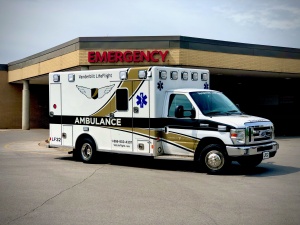
- October 2020: Vanderbilt LifeFlight is named the Association of Air Medical Services National Program of the Year. This prestigious award, sponsored by Airbus Helicopters, recognizes an air medical program that has demonstrated a superior level of patient care, management prowess and quality leadership through visionary and innovative approaches, customer service, safety consciousness, community service and commitment to the medical transport community. The award has been presented since 1997. While this marks the first time a Tennessee program has received the honor, it’s not the first time Vanderbilt LifeFlight has received national recognition from AAMS. In 2005, LifeFlight Executive Director, Jeanne Yeatman, received the “AAMS Excellence in Transport Leadership Award” and in 2003, former flight nurse Kevin High received the “Crew Member of the Year” award.
- June 2021 - LifeFlight Ground Clarksville was established, making the first transport on June 19, 2021.
- July 2021 - LifeFlight Ground Tullahoma was established, staffing the first ambulance on July 23, 2021.
- September 2021 - Sherri Dean and Laura Price were named to the executive leadership team, marking a move to VUMC's triad leadership model. Dr. Stephan Russ, Dean and Price make up the executive leadership team. They replaced longtime LifeFlight leader Jeanne Yeatman, who was named chief nursing officer at Vanderbilt Wilson County Hospital.
- February 2022 - LifeFlight 10, LifeFlight's airplane, moved from the Nashville International Airport to the Lebanon Municipal Airport.
- 2023- Non-medical Stretcher Van Transport: To support and improve patient flow, LifeFlight offers wheelchair and stretcher van transport for patients who require special handling, but do not require medical attendance during transport. These vans are staffed by Clinical Technicians that are focused on providing a safe and caring transport. We have three wheelchair vans that can accommodate Staxi transport chairs. Our stretcher van is configured to allow patients that are not able to sit upright in a wheelchair, or that have other orthopedic appliances that impede transport in a wheelchair or traditional vehicle. We are staffed 24/7 with primary service to the VUMC main campus with the ability to extend to the Vanderbilt Health Regional Hospitals as needed.
- November 1983: The Tennessee Health Facilities Commission approves Vanderbilt University Medical Center's application to start Middle Tennessee's first air medical transport service.
-

LifeFlight adopted this crew patch in February 2022. It encompasses the comprehensive approach to patient transport. It replaces the crew patch that has been used since 2012. It continued with the reflective silver background for safety. 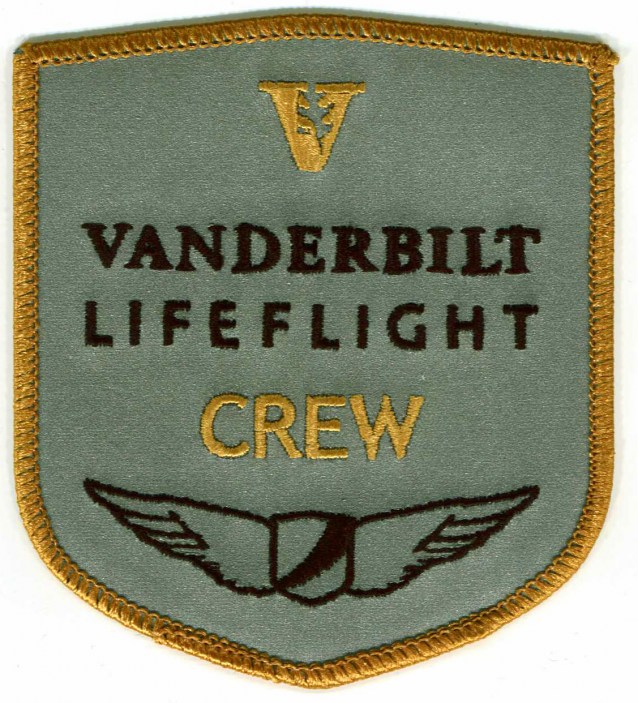
LifeFlight's Crew patch, adopted from 2012 - 2022. The patch has a silver reflective background and is LifeFlight's first reflective crew patch, an added design for crew safety. 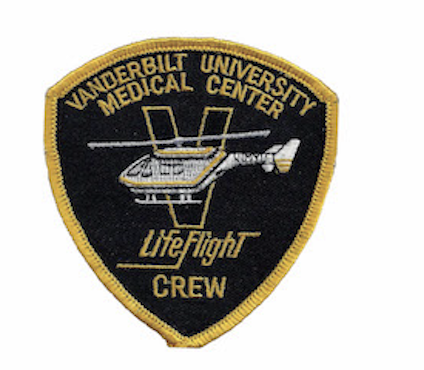
This is the original crew patch used in 1988. 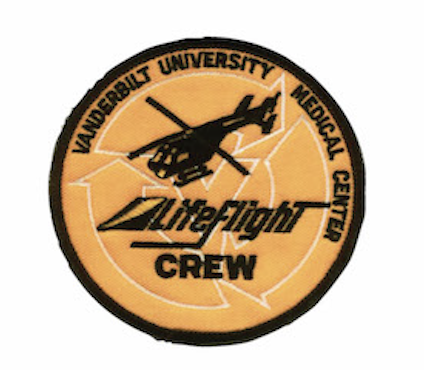
This patch was used as a crew patch from 1998 to 2001. 
The second version of the "crew" patch, used from 2002 to 2012. 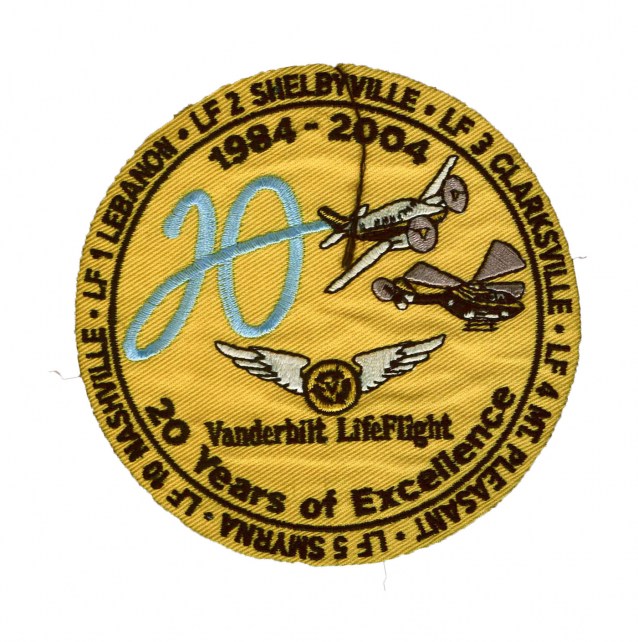
The 20th anniversary crew patch, used in 2004. 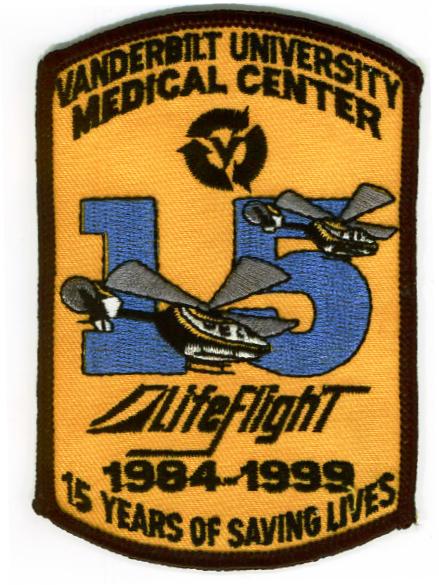
15 year anniversary crew patch that was used in 1999. 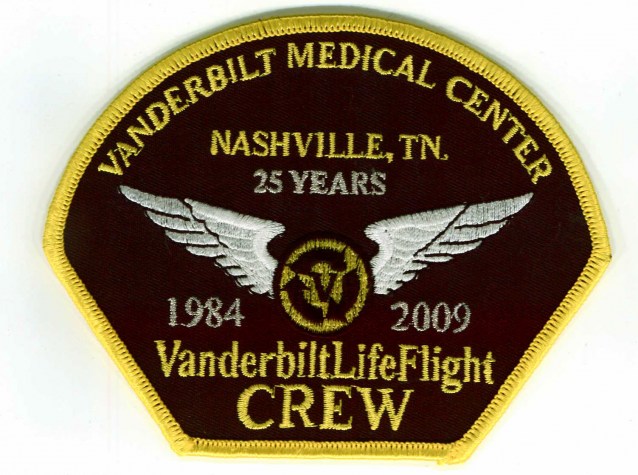
25 year anniversary patch used in 2009. 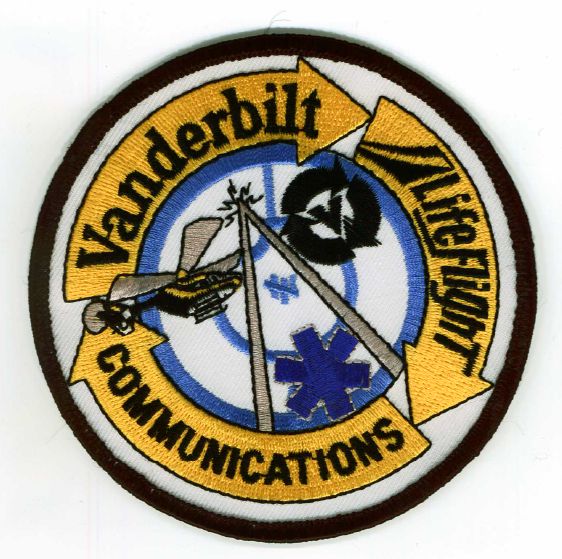
This patch was created in 2001 for the emergency communications division of LifeFlight. 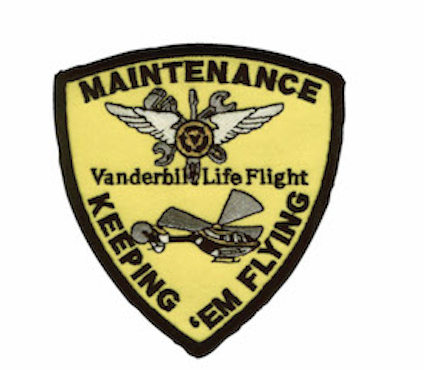
This patch was created for the maintenance division of LifeFlight in 2003. 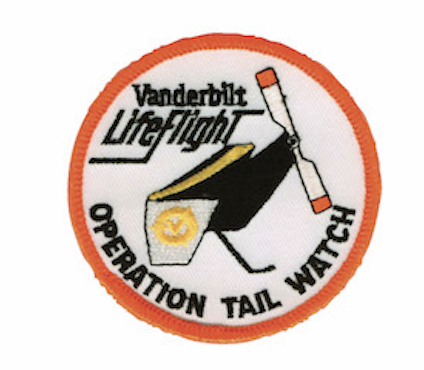
Operation Tail Watch class patch, given to emergency responders who complete the safety program, Operation Tail Watch. This patch was adopted in 1998. 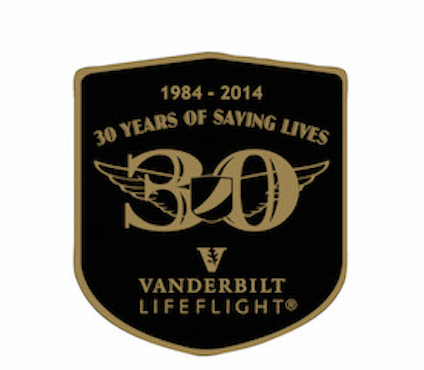
LifeFlight celebrates 30 years of service with this patch. 
LifeFlight celebrates 35 years of service with this patch. 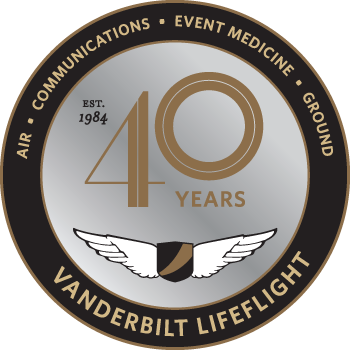
LifeFlight recently celebrated 40 years of service in 2024 with this special patch.
-

The first LifeFlight logo, created when the department was created in 1984 and used until 2001. The "swoosh" on the front of the word symbolizes the tail fin off the aircraft. 
This logo replaced the original one in 2002 and was used until 2011. It brought in elements that also represented Vanderbilt University Medical Center - the "hubcap" symbol that was part of the hospital logo, and added the words "Vanderbilt" 
Vanderbilt University Creative Services created this logo, incorporating the original swoosh, along with the wings, and added the Vanderbilt "V" along with the words 'Vanderbilt LifeFlight' under the wings. This was introduced in October, 2011 and remains in use today on uniforms and vehicles. 
This was introduced in 2016 and is the official marking of Vanderbilt LifeFlight